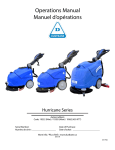Download owners manual - Scorpio
Transcript
MODEL 3903 owners manual INTRODUCTION 3 BEFORE YOU PROCEED 4 SAFETY PRECAUTIONS 5 TOOLS, SUPPLIES AND REQUIRED EQUIPMENT 6 ANATOMY OF THE E-MAXX 7 QUICK START: GETTING UP TO SPEED 8 TRAXXAS TQ 2.4GHZ SYSTEM 16 ADJUSTING THE ELECTRONIC SPEED CONTROL 18 DRIVING YOUR MODEL 21 TUNING ADJUSTMENTS 26 MAINTAINING YOUR MODEL 27 TROUBLESHOOTING 28 TQ 2.4GHZ ADVANCED TUNING GUIDE 2 • E-MAXX Thank you for purchasing the new Traxxas E-Maxx electric monster truck. When it comes to gut-wrenching, wheelie-popping monster torque, nothing comes close to E-Maxx. We are confident you will appreciate the latest performance and appearance enhancements that have been made to this legendary model. With tough twin Titan® 550 motors and a powerful EVX-2 electronic speed control, the E-Maxx is built for rock-stomping action. The new chassis and water-resistant electronics are made to take abuse. Even innovative technology from our top-of-the-line Revo® has found it’s way into E-Maxx in the form of the patent-pending Torque-Control™ slipper and sealed driveshafts. This manual contains the instructions you will need to operate, and maintain your model so that you can enjoy it for years to come. We want you to feel confident that you own one of the bestperforming models in the market and that it is backed by a team of professionals who aim to provide the highest level of factory support possible. Traxxas models are about experiencing total performance and satisfaction, not just with your model, but also with the company that stands behind it. We know you’re excited about getting your new model on the road, but it’s very important that you take some time to read through the Owners Manual. This manual contains all the necessary set-up and operating procedures that allow you to unlock the performance and potential that Traxxas engineers designed into your model. Even if you are an experienced R/C enthusiast, it’s important to read and follow the procedures in this manual. Thank you again for going with Traxxas. We work hard every day to assure you the highest level of customer satisfaction possible. We truly want you to enjoy your new model! Traxxas Support Traxxas support is with you every step of the way. Refer to the next page to find out how to contact us and what your support options are. Quick Start This manual is designed with a Quick Start path that outlines the necessary procedures to get your model up and running in the shortest time possible. If you are an experienced R/C enthusiast you will find it helpful and fast. Be sure and read through the rest of the manual to learn about important safety, maintenance, and adjustment procedures. Turn to page 7 to begin. BEFORE YOU PROCEED Carefully read and follow all instructions in this and any accompanying materials to prevent serious damage to your model. Failure to follow these instructions will be considered abuse and/or neglect. Support Before running your model, look over this entire manual and examine the model carefully. If for some reason you decide it is not what you wanted, then do not continue any further. Your hobby dealer absolutely cannot accept a model for return or exchange after it has been run. Technical support is available Monday through Friday from 8:30am to 9:00pm central time. Technical assistance is also available at Traxxas.com. You may also e-mail customer support with your question at [email protected]. Join thousands of registered members in our online community at Traxxas.com. Warnings, helpful hints, & cross-references An important warning about personal safety or avoiding damage to your model and related components. Traxxas offers a full-service, on-site repair facility to handle any of your Traxxas service needs. Maintenance and replacement parts may be purchased directly from Traxxas by phone or online at BuyTraxxas.com. You can save time, along with shipping and handling costs, by purchasing replacement parts from your local dealer. Special advice from Traxxas to make things easier and more fun. Do not hesitate to contact us with any of your product support needs. We want you to be thoroughly satisfied with your new model! Throughout this manual, you’ll notice warnings and helpful hints identified by the icons below. Be sure to read them! If you have any questions about your model or its operation, call the Traxxas Technical Support line toll-free at: 1-888-TRAXXAS (1-888-872-9927)* Refers you to a page with a related topic. *Toll-free support is available to U.S. residents only. Traxxas 1100 Klein Road Plano, Texas 75074 Phone: 972-265-8000 Toll-free 1-888-TRAXXAS Traxxas U.K. P.O. Box 1128 Winterbourne, Bristol BS36-2SH England Phone: 44-117-956-1002 Internet Traxxas.com E-mail: [email protected] Entire contents ©2010 Traxxas. Traxxas, Ready-To-Race, ReadyTo-Win, E-Maxx and ProGraphix are trademarks or registered trademarks of Traxxas. Other brand names and marks are the property of their respective holders and are used only for purposes of identification. No part of this manual may be reproduced or distributed in print or electronic media without the express written permission of Traxxas. Specifications are subject to change without notice. E-MAXX • 3 el = Myriad Semi Bold SAFETY PRECAUTIONS 2 3 3+ 4 5 This model is not intended for use by children under 14 years of age without the supervision of a responsible and knowledgeable adult. Your model is not intended for use on public roads or congested areas where its operation can conflict with or disrupt pedestrian or vehicular traffic. Never, under any circumstances, operate the model in crowds of people. Your model is very fast and could cause injury if allowed to collide with anyone. Because your model is controlled by radio, it is subject to radio interference from many sources that are beyond your control. Since radio interference can cause momentary losses of radio control, always allow a safety margin in all directions around the model in order to prevent collisions. The motors, batteries, and speed control can become hot during use. Be careful to avoid getting burned. Don’t operate your model at night, or anytime your line of sight to the model may be obstructed or impaired in any way. Most importantly, use good common sense at all times. Batteries and Battery Charging Previous experience with radio controlled models is recommended. Models require a higher level of setup, maintenance, or support equipment. ForExpertDrivers 1 4 • E-MAXX Your model uses rechargeable batteries that must be handled with care for safety and long battery life. Make sure to read and follow all instructions and precautions that were provided with your battery packs and your charger. It is your responsibility to charge and care for your battery packs properly. In addition to your battery and charger instructions, here are some more tips to keep in mind. Never leave batteries to charge unattended. Remove the batteries from the model while charging. Always unplug the batteries from the electronic speed control when the model is not in use and when it is being stored or transported. Allow the battery packs to cool off between runs (before charging). Children should have responsible adult supervision when charging and handling batteries. Do not use battery packs that have been damaged in any way. Do not use battery packs that have damaged wiring, exposed wiring, or a damaged connector. Only use approved chargers for NiMH battery packs (such as the Traxxas EZ-Peak™ Charger, Part #2930). Do not exceed the maximum charge rate of 4 amps. Do not short-circuit the battery pack. This may cause burns and severe damage to the battery pack. Speed Control Disconnect the Batteries: Always disconnect the batteries from the speed control when not in use. Transmitter on First: Switch on your transmitter first before switching on the speed control to prevent runaways and erratic performance. TEXT HAS BEEN on Don’t Get Burned:BELOW The heat sink can get extremely hot,UPDATED so be careful not to 3-14-07 touch it until it is Kent cool. Supply adequate airflow for cooling. wants maintenance text to be at the END 6 to 14-cells Only: Always adhere to the minimum and maximum limitations of the EVX-2 as stated in the specifications table. Do not mix battery types and capacities. Use the same with radio controlled models is required. No previous experience N voltage require and capacity for bothof setup, maintenance, or support equipment. Models a minimum M Do not mix battery Do not use a 6-cell 7.2V batteries. Using mismatched capacities. Use two battery in combination battery packs could damage batteries with the with a 7-cell battery same capacity. 8.4V pack. the batteries and electronic Previous experience with radio controlled models is recommended. M speed control. Models require a higher level of setup, maintenance, or support equipment. Use Stock Connectors: If you decide to change the battery P or motor connectors, one batterymodels or motor at aThese time. Previous experienceonly withchange radio controlled isconnector mandatory. c This will prevent damage from accidentally mis-wiring the speed control. models are capable of high speeds, requiring experienced driving control. d Please note that modified speed controls can be subject to a rewiring fee Models require detailed setup, and/or maintenance procedures with required e when returned for service. Removing the battery connector on the speed support equipment. control or using connectors with no reverse-polarity protection on the speed Previous with radio controlled models is mandatory. P control willexperience void the product’s warranty. areAlways capable of very high speeds and require an even c These Insulatemodels the Wires: insulate exposed or damaged wiring with heat higher level skilledtodriving Models require detailed setup, and/or maintec shrinkoftubing preventcontrol. short circuits with required support equipment. r nance Alwaysprocedures Use Heat Sinks: Three heat sinks are factory-installed on the speed control and must be used forThis maximum cooling and performance. For Expert Drivers Only. product is capable of extreme speed and No Reverse Voltage:ItThe speedour control is notskill protected against reverse polarity acceleration! carries highest level rating and is intended F voltage. When changing battery and/or motor, be sure toradio installcontrolled the same for expert drivers only. the Experience with nitro-powered a type of connectors to avoid reverse polarity damage to the speed control. models is required! f Removing the battery connectors on the speed control or using the samem gender connectors on the speed control will void the product’s warranty. Do Not Let the Transistor Tabs Touch: Never allow the three separate transistor banks to touch each other or any exposed metal. This will create a short circuit and damage the speed control. (For example, laying a metal tool across the heat sinks can damage the speed control.) No Schottky Diodes: External Schottky diodes are not compatible with reversing speed controls. Using a Schottky diode with the EVX-2 will damage the ESC and void the 30-day warranty. Choose the Model That is Right For You. 15 0 0 bluehighway font Important Points to Remember Do not burn or puncture the batteries. Toxic materials could be released. If eye or skin contact occurs, flush with water. Store the battery pack in a dry location, away from heat sources and direct sunlight. Nickel Metal Hydride batteries must be recycled or disposed of properly. 3 6 All of us at Traxxas want you to safely enjoy your new model. Operate your model sensibly and with care, and it will be exciting, safe, and fun for you and those around you. Failure to operate your model in a safe and responsible manner may result in property damage and serious injury. The precautions outlined in this manual should be strictly followed to help ensure safe operation. You alone must see that the instructions are followed and the precautions are adhered to. 15 0 3 0 6 0 0 All instructions and precautions outlined in this manual should be strictly followed to ensure safe operation of your model. TOOLS, SUPPLIES AND REQUIRED EQUIPMENT Your model comes with a set of specialty metric tools. You’ll need to purchase other items, available from your hobby dealer, to operate and maintain your model. Supplied Tools and Equipment 2.0mm “T” wrench Suspension multi-tool 1.5mm “L” wrench Antenna nut wrench 2.5mm “L” wrench 8mm/5mm wrench Pre-load spacers and shock pistons (on parts tree) see page 20 Universal wrench Two 7-cell NiMH battery packs with Traxxas High-Current Connectors* Body clips Foam blocks (battery spacers) see page 12 Warning: Lithium Polymer (LiPo) batteries should not be used with the EVX-2. The EVX-2 electronic speed control is not equipped with low-voltage detection. Required Equipment (sold separately) 4 AA alkaline batteries For more information on batteries, see Use the Right Batteries on page 11. A peak-detecting charger is recommended for best performance and longest battery life. For more information, see Use the Right Charger on page 12. Recommended Equipment These items are not required for the operation of your model, but are a good idea to include in any R/C toolbox: • Safety glasses • Thin, hobby-quality cyanoacrylate instant tire glue (CA glue) • Hobby knife • Side cutters and/or needle nose pliers • Philips screwdriver • Soldering iron NiMH battery charger (TRX EZ-Peak™ shown, Part #2930) *Battery style is subject to change and may vary from images. E-MAXX • 5 ANATOMY OF THE E-MAXX Half Shaft Steering Servo Slipper Clutch Access Plug Toe Link (Turnbuckle) Pivot Ball Pinion Gear (left side) Battery Hold-Down Electronic Speed Control (EVX-2) Hex Hub Battery Compartment Axle Carrier Toe Link (Turnbuckle) Motors (Titan) Suspension Arm (Front) Rear Body Mount Front Body Mount Rear Shock Tower Receiver Box Skid Plate Skid Plate Front Bumper Rear Bumper Rear Bulkhead Transmission Chassis Spur Gear Rear Differential Battery Hold-Down 6 • Traxxas Front Bulkhead Battery Compartment Antenna Mount Suspension Arm (Rear) Front Differential Steering Servo Light Pipe Front Shock Tower Ultra Shock™ (Oil Damper) QUICK START: GETTING UP TO SPEED The following guide is an overview of the procedures for getting your model running. Look for the Quick Start logo on the bottom corners of Quick Start pages. 1. Read the safety precautions on page 4 For your own safety, understand where carelessness and misuse could lead to personal injury. 2. Charge the battery packs • See sidebar, page 12 Fully charge the two included battery packs. Charge your batteries now so it will be ready when you finish the other setup procedures. 3. Install batteries in the transmitter • See page 11 The transmitter requires 4 AA alkaline or rechargeable batteries. 8. Detail your model • See page 8 Apply other decals if desired. 9. Drive your model • See page 18 Driving tips and adjustments for your model. The Quick Start Guide is not intended to replace the full operating instructions available in this manual. Please read this entire manual for complete instructions on the proper use and maintenance of your model. 10. Maintain your model • See page 26 Follow these critical steps to maintain the performance of your model and keep it in excellent running condition. 4. Install battery packs in the model • See page 12 Your model requires two fully charged battery packs (included). 5. Turn on the radio system • See page 13 Make a habit of turning the transmitter on first, and off last. 6. Check servo operation • See page 14 Make sure the steering servos are working correctly. 7. Range test the radio system • See page 14 Follow this procedure to make sure your radio system works properly at a distance and that there is no interference from outside sources. Look for the Quick Start logo at the bottom of Quick Start pages. E-MAXX • 7 TRAXXAS TQ 2.4GHz SYSTEM INTRODUCTION Applying the Decals The main decals for your model have been applied at the factory. The decals are printed on self-adhesive clear mylar and are die-cut for easy removal. Use a hobby knife to lift the corner of a decal and lift it from the backing. Your model includes the latest Traxxas TQ 2.4GHz transmitter with Traxxas Link™ technology. The transmitter’s easy-to-use design provides instant driving fun for new R/C enthusiasts, and also offers a full compliment of pro-level tuning features for advanced users – or anyone interested in experimenting with the performance of their model. The steering and throttle channels feature adjustable Exponential, End Points, and SubTrims. Steering and braking Dual Rate are also available. Many of the next-level features are controlled by the Multi-Function knob, which can be programmed to control a variety functions. The detailed instructions (page 28) and Menu Tree (page 30) included in this manual will help you understand and operate the advanced functions of the new TQ 2.4GHz radio system. For additional information and how-to videos, visit Traxxas.com. RADIO AND POWER SYSTEM TERMINOLOGY To apply the decals, place one end down, hold the other end up, and gradually smooth the decal down with your finger as you go. This will prevent air bubbles. Placing both ends of the decal down and then trying to smooth it out will result in air pockets. Look at the photos on the box for typical decal placement. Please take a moment to familiarize yourself with these radio and power system terms. They will be used throughout this manual. A detailed explanation of the advanced terminology and features of your new radio system begins on page 28. BEC (Battery Eliminator Circuit) - The BEC can either be in the receiver or in the ESC. This circuit allows the receiver and servos to be powered by the main battery pack in an electric model. This eliminates the need to carry a separate pack of 4 AA batteries to power the radio equipment. Current - Current is a measure of power flow through the electronics, usually measured in amps. If you think of a wire as a garden hose, current is a measure of how much water is flowing through the hose. ESC (Electronic Speed Control) - An electronic speed control is the electronic motor control inside the model. The EVX-2 uses MOSFET power transistors to provide precise, digital proportional throttle control. Electronic speed controls use power more efficiently than mechanical speed controls so that the batteries run longer. An electronic speed control also has circuitry that prevents loss of steering and throttle control as the batteries lose their charge. 8 8 • E-MAXX 550 and 540 - These numbers refer to the size of the motor. 550 motors have armatures that are 30% longer than 540 motors. Frequency band - The radio frequency used by the transmitter to send signals to your model. This model operates on the 2.4GHz direct-sequence spread spectrum. mAh – Abbreviation for milliamp hour. A measure of the capacity of the battery pack. The higher the number, the longer the battery will last between recharges. Neutral position - The standing position that the servos seek when the transmitter controls are at the neutral setting. NiCad - Abbreviation for nickel-cadmium. The original rechargeable hobby pack, NiCad batteries have very high current handling, high capacity, and can last up to 1000 charging cycles. Good charging procedures are required to reduce the possibility of developing a “memory” effect and shortened run times. NiMH - Abbreviation for nickel-metal hydride. Rechargeable NiMH batteries offer high current handling, and much greater resistance to the “memory” effect. NiMH batteries generally allow higher capacity than NiCad batteries. They can last up to 500 charge cycles. A peak charger designed for NiMH batteries is required for optimal performance. Receiver - The radio unit inside your model that receives signals from the transmitter and relays them to the servos. Resistance - In an electrical sense, resistance is a measure of how an object resists or obstructs the flow of current through it. When flow is constricted, energy is converted to heat and is lost. Servo - Small motor unit in your model that operates the steering mechanism. Transmitter - The hand-held radio unit that sends throttle and steering instructions to your model. Trim - The fine-tuning adjustment of the neutral position of the servos, made by adjusting the throttle and steering trim knobs on the face of the transmitter. Note: The Multi Function knob must be programmed to serve as a throttle trim adjustment. Thermal Shutdown Protection - Temperature sensing electronics are used in the ESC to detect overloading and overheating of the transistor circuitry. If excessive temperature is detected, the unit automatically shuts down to prevent damage to the electronics. TRAXXAS TQ 2.4GHz SYSTEM 2-channel radio system - The TQ radio system, consisting of the receiver, the transmitter, and the servos. The system uses two channels: one to operate the throttle and one to operate the steering. 2.4GHz Spread Spectrum – This model is equipped with the latest R/C technology. Unlike AM and FM systems that require frequency crystals and are prone to frequency conflicts, the TQ 2.4GHz system automatically selects and locks onto an open frequency, and offers superior resistance to interference and “glitching.” Voltage - Voltage is a measure of the electrical potential difference between two points, such as between the positive battery terminal and ground. Using the analogy of the garden hose, while current is the quantity of water flow in the hose, voltage corresponds to the pressure that is forcing the water through the hose. To prevent loss of radio range do not kink or cut the black wire, do not bend or cut the metal tip, and do not bend or cut the white wire at the end of the metal tip. Correct No No No IMPORTANT RADIO SYSTEM PRECAUTIONS For maximum range, always hold the transmitter so the antenna is in a vertical position (pointing straight up). The transmitter’s antenna can be swiveled and angled to allow for a vertical position if necessary. Do not kink the receiver’s antenna wire. Kinks in the antenna wire will reduce range. DO NOT CUT any part of the receiver’s antenna wire. Cutting the antenna will reduce range. Extend the antenna wire in the model as far as possible for maximum range. It is not necessary to extend the antenna wire out of the body, but wrapping or coiling the antenna wire should be avoided. Do not allow the antenna wire to extend outside the body without the protection of an antenna tube, or the antenna wire may get cut or damaged, reducing range. It is recommended to keep the wire inside the body (in the antenna tube) to prevent the chance of damage. E-MAXX • 9 TRAXXAS TQ 2.4GHz SYSTEM EVX-2 Wiring Diagram Your model is equipped with the newest Traxxas 2.4 GHz transmitter with Traxxas Link.™ The transmitter has two channels for controlling your throttle and steering. The receiver inside the model has 5 output channels. Your model is equipped with one servo and an electronic speed control. Wiring Diagram Channel 1 Steering Servos Antenna Motors (Titan®) TQ 2.4GHz Transmitter Receiver Antenna Multi-Function Knob Steering Wheel Throttle Neutral Adjust Steering Trim High-Current Connector F S O E O R V P .8 R E 16 T A W BATT/CH5, CH4 and CH3 are not used C Channel 2 EVX-2 Electronic Speed Control EVX-2 Electronic Speed Control To Motor Throttle Trigger High-Current Battery Connector W AT ER 16.8 V EPROOF SC Heat Sinks Power Switch 10 • E-MAXX Battery Compartment Set Button Menu Button Red/Green Status LED see page 29 for more info LED EZ-Set Button TRAXXAS TQ 2.4GHz SYSTEM INSTALLING TRANSMITTER BATTERIES Your TQ transmitter uses 4 AA batteries. The battery compartment is located in the base of the transmitter. If the power indicator doesn’t light green, check the polarity of the batteries. Check rechargeable batteries for a full charge. If you see any other flashing signal from the LED, refer to the chart on page 29 to identify the code. Use the Right Batteries 1.Remove the battery compartment door by pressing the tab and lifting the door up.* 2.Install the batteries in the correct orientation as indicated in the battery compartment. 3.Reinstall the battery door and snap it closed. 4.Turn on the transmitter and check the status indicator for a solid green light. If the status LED flashes red, the transmitter batteries may be weak, discharged or possibly installed incorrectly. Replace with new or freshly charged batteries. The power indicator light does not indicate the charge level of the battery pack installed in the model. Refer to the Troubleshooting section on page 29 for more information on the transmitter Status LED codes. Your transmitter uses AA batteries. Use new alkaline batteries, or rechargeable batteries such as NiMH (Nickel Metal Hydride) batteries in your transmitter. Make sure rechargeable batteries are fully charged according to the manufacturer’s instructions. If you use rechargeable batteries in your transmitter, be aware that when they begin to lose their charge, they lose power more quickly than regular alkaline batteries. Caution: Discontinue running your model at the first sign of weak batteries (flashing red light) to avoid losing control. 3 *Always keep your Quick Reference Guide in your transmitter. E-MAXX • 11 TRAXXAS TQ 2.4GHz SYSTEM INSTALLING BATTERY PACKS Using the Right Charger The most convenient type of charger for charging the included battery packs is an AC peak-detecting charger that plugs directly into an AC wall outlet, such as the TRX EZ-Peak™ (Part #2930). It contains special peak-detection circuitry that automatically shuts the charger off when the battery is fully charged. For faster charging, the included battery may be charged at 4 amps. The TRX EZ-Peak is a 4 amp charger and will charge the included battery in about 45 minutes! Caution: Never use a 15-minute timed charger to recharge your model’s battery packs. Overcharging may result, causing damage to the battery packs. Note that one side is labeled “25” and other side is labeled “23”. The 25mm side is for use with typical stick type battery packs. If you are using side-by-side racing packs, simply flip the hold-down over to the 23mm side and use it on the opposite side of the chassis. Accessory hold downs and foam (part #3927X) are available to accommodate larger battery packs. See the 3903 E-Maxx parts list for more information. The included batteries must be fully charged before installation in the model. The battery packs should be removed from the vehicle before charging. Do not leave the battery unattended while charging. 1. Remove the battery hold-down by pressing on the release tab and lifting out the hold-down. 2. Install the battery pack with the battery wires facing the rear of the model. 3. Insert the tabs of the battery hold-down into the slots in the rear hold-down retainer (A). Swing the battery hold down towards the chassis and snap (lock) the end into the front hold-down retainer (B). When using 6-cell battery packs, install the supplied foam block (spacer) into the front of the battery compartment. The spacers are located in your instructions package. The spacers are shaped to conform to the chassis. There is a right and a left. Test fit them to confirm their location. Remove the backing from the self adhesive strips and secure them to the front of the battery compartments. Release Tab Using Different Battery Configurations The battery hold-downs are “25” - Standard stick packs capable of accommodating either side-by-side racing style packs or the more common stick packs. The battery compartments are configured for stick packs from the factory. The number on each side of the hold down indicates the battery height in millimeters that hold“23” - Side-by-side packs down can accommodate. 25mm side: Standard NiMH stick pack setup 23mm side: Side-by-side NiMH pack setup 2,4 12 • E-MAXX The Traxxas High Current Connector Your model is equipped with the Traxxas HighCurrent Connector. Standard connectors restrict current flow and are not capable of delivering the power needed to maximize the output of the EVX-2. The Traxxas connector’s gold-plated terminals with a large contact surfaces ensure positive current flow with the least amount of resistance. Secure, long-lasting, and easy to grip, the Traxxas connector is engineered to extract all the power your battery has to give. TRAXXAS TQ 2.4GHz SYSTEM TQ 2.4GHz RADIO SYSTEM CONTROLS In order for the transmitter and receiver to bind to one another, the receiver in the model must be turned on within 20 seconds of turning on the transmitter. The transmitter LED will flash fast red indicating a failure to link. If you miss it, simply turn off the transmitter and start over. Remember, always turn the TQ transmitter on first and off last to avoid damage to your model. Always turn on the transmitter before plugging in the battery. TQ 2.4GHz Radio System Basic Adjustments Throttle Neutral Adjustment The throttle neutral adjustment is located on the transmitter face and controls the forward/reverse travel of the throttle trigger. Change the adjustment by pressing the button and sliding it to the desired position. There are two settings available: The following Traxxas High Current Connector packages are available from your hobby dealer. When using adapters, be careful not to exceed the current rating of the Molex connector. 50/50: Allows equal travel for both acceleration and reverse. 70/30: Allows more throttle travel (70%) and less reverse travel (30%). TQ RADIO SYSTEM RULES Always turn your TQ 2.4GHz transmitter on first and off last. This procedure will help to prevent your model from receiving stray signals from another transmitter, or other source, and running out of control. Your model has electronic fail-safes to prevent this type of malfunction, but the first, best defense against a runaway model is to always turn the transmitter on first, and off last. Always use new or freshly charged batteries for the radio system. Weak batteries will limit the radio signal between the receiver and the transmitter. Loss of the radio signal can cause you to lose control of your model. Note: We strongly recommend to leave this control in its factory location until you become familiar with all the adjustments and capabilities of your model. To change the throttle neutral adjust position, turn the transmitter off before adjusting the neutral position. You will need to reprogram your electronic speed control to recognize the 70/30 setting. Turn to ESC Setup Programming on page 16 for instructions. Steering Trim The electronic steering trim located on the face of the transmitter adjusts the neutral (center) point of the steering channel. Part #3060 Single Male/Female Part #3080 2-Pack Female Part #3061 Male Charge Adapter Part #3070 2-Pack Male 100 0 Multi-Function Knob The Multi-Function knob can be programmed to control a variety of functions. From the factory, the 100 Multi-Function knob controls steering sensitivity, 0 also known as exponential or “expo.” When the knob is turned counterclockwise all the way to the left (default position), expo is off and steering sensitivity will be linear (the most commonly used setting). Turning the knob clockwise will “add expo” and decrease the steering sensitivity in the initial range of steering wheel travel left or right from center. For more detail on steering exponential, refer to page 15. LE TRIM THROTT Part #3062 Female Charge Adapter LE TRIM THROTT 1 2 3 Always turn your transmitter on first. Plug in the battery. Turn on the model. 5 E-MAXX • 13 TRAXXAS TQ 2.4GHz SYSTEM Using the TQ 2.4GHz Radio System Using Reverse: While driving, push the throttle trigger forward to apply brakes. Once stopped, return the throttle trigger to neutral. Push the throttle trigger forward again to engage proportional reverse. Automatic Fail-Safe The TQ 2.4GHz transmitter and receiver are equipped with an automatic failsafe system that does not require user programming. In the event of signal loss or interference, the throttle will return to neutral and the steering will hold its last commanded position. If failsafe activates while you are operating your model, determine the reason for signal loss and resolve the problem before operating your model again. When rechargeable batteries begin to lose their charge, they will fade much faster than alkaline dry cells. Stop immediately at the first sign of weak batteries. Never turn the transmitter off when the battery pack is plugged in. The model could run out of control. The TQ 2.4GHz Radio System has been pre-adjusted at the factory. The adjustment should be checked before running the model, in case of movement during shipping. Here’s how: 1. Turn the transmitter switch on. The status LED on the transmitter should be solid green (not flashing). 2. Elevate the model on a block or a stand so that all the tires are off the ground. Make sure your hands are clear of the moving parts of the model. 3. Plug the battery pack in the model into the speed control. 4. The on/off switch is integrated into the speed control. With the transmitter on, press the EVX-2 set button for ½ second, until the LED shines GREEN, then immediately release the button. This turns the model on (see page 16 for more on EVX-2 setup and operation). To turn the EVX-2 off, press the set button until the green LED turns off. Always disconnect your batteries when the model is not in use. 14 • E-MAXX 1. Turn on the radio system and check its operation as described in the previous section. 2. Have a friend hold the model. Make sure hands and clothing are clear of the wheels and other moving parts on the model. 3. Make sure your transmitter antenna is straight up, and then walk away from the model with the transmitter until you reach the farthest distance you plan to operate the model. 4. Operate the controls on the transmitter once again to be sure that the model responds correctly. 5. Do not attempt to operate the model if there is any problem with the radio system or any external interference with your radio signal at your location. • Higher Speeds Require Greater Distance The faster you drive your model, the more quickly it will near the limit of radio range. At 60mph, a model can cover 88 feet every second! It’s a thrill, but use caution to keep your model in range. If you want to see your model achieve its maximum speed, it is best to position yourself in the middle of the truck’s running area, not the far end, so you drive the truck towards and past your position. In addition to maximizing the radio’s range, this technique will keep your model closer to you, making it easier to see and control. No matter how fast or far you drive your model, always leave adequate space between you, the model, and others. Never drive directly toward yourself or others. 5. Turn the steering wheel on the transmitter back and forth and check for rapid operation of the steering servo. Also, check that the steering mechanism is not loose or binding. If the steering operates slowly, check for weak batteries. 6. When looking down at model, the front wheels should be pointing straight ahead. If the wheels are turned slightly to the left or right, slowly adjust the steering trim control on the transmitter until they are pointing straight ahead. 7. Gently operate the throttle trigger to ensure that you have forward and reverse operation, and that the motor stops when the throttle trigger is at neutral. Warning: Do not apply full throttle in forward or reverse while the model is elevated. 8. Once adjustments are made, turn off the receiver on your model, followed by the hand-held transmitter. 6,7 Range-Testing the Radio System Before each running session with your model, you should range-test your radio system to ensure that it operates properly. TQ 2.4GHz Binding Instructions For proper operation, the transmitter and receiver must be electronically ‘bound.’ This has been done for you at the factory. Should you ever need to re-bind the system or bind to an additional transmitter or receiver, follow these instructions. Note: the receiver must be connected to a 4.8-6.0v (nominal) power source for binding and the transmitter and receiver must be within 5 feet of each other. 1. Press and hold the transmitter’s SET button as you switch transmitter on. The transmitter’s LED will flash red slowly. Release the SET button TRAXXAS TQ 2.4GHz SYSTEM 2. Press and hold the receiver’s LINK button as you switch on the speed control by pressing the EZ-Set button. Release the LINK button. 3. When the transmitter and receiver’s LEDs turn solid green, the system is bound and ready for use. Confirm that the steering and throttle operate properly before driving your model. Steering Sensitivity (Exponential) The Multi-Function knob on the TQ 2.4GHz transmitter has been programmed to control Steering Sensitivity (also known as exponential). The standard setting for Steering Sensitivity is “normal (zero exponential),” with the dial full left in its range of travel. This setting provides linear servo response: the steering servo’s movement will correspond exactly with the input from the transmitter’s steering wheel. Turning the knob clockwise from the left will result in “negative exponential” and decrease steering sensitivity by making the servo less responsive near neutral, with increasing sensitivity as the servo nears the limits of its travel range. The farther you turn the knob, the more pronounced the change in steering servo movement will be. The term “exponential” comes from this effect; the servo’s travel changes exponentially relative to the input from the steering wheel. The exponential effect is indicated as a percentage—the greater the percentage, the greater the effect. The illustrations below show how this works. Normal Steering Sensitivity (0% exponential) In this illustration, the steering servo’s travel (and with it, the steering motion of the model’s front wheels) corresponds precisely with the steering wheel. The ranges are exaggerated for illustrative purposes. Decreased Steering Sensitivity (Negative Exponential) By turning the Multi-Function knob clockwise, the steering sensitivity of the model will be decreased. Note that a relatively large amount of steering wheel travel results in a smaller amount of servo travel. The farther you turn the knob, the more pronounced the effect becomes. Decreased steering sensitivity may be helpful when driving on low-traction surfaces, when driving at high speed, or on tracks that favor sweeping turns where gentle steering inputs are required. The ranges are exaggerated for illustrative purposes. Turning Range at Transmitter Effective Turning Range on Model To prevent loss of radio range do not kink or cut the black wire, do not bend or cut the metal tip, and do not bend or cut the white wire at the end of the metal tip. Correct No No No Experiment! Try varying degrees of exponential. It’s easy to go back to “zero” if you don’t like the effect. There’s no wrong way to adjust exponential. Any setting that makes you more comfortable with your car’s handling is the “right setting.” SETTING UP THE ANTENNA The receiver antenna has been set up and installed from the factory. When reinstalling the antenna, first slide the antenna wire into bottom of antenna tube until white tip of antenna is at top of tube under the black cap. Insert the base of the tube into the antenna post. Take care not to crimp the antenna wire. Slide the crimp nut over the antenna tube and screw it onto the antenna post. Use the supplied tool to tighten the crimp nut on the post just until the antenna tube is securely in place. Do not over tighten or crush the antenna wire against the chassis. Do not bend or kink the antenna wire! See the side bar for more information. Do not shorten the antenna tube. Antenna Tip Antenna Tube Antenna Nut Wrench Antenna Nut Antenna Mount E-MAXX • 15 ADJUSTING THE ELECTRONIC SPEED CONTROL EVX-2 Specifications Input voltage: 6 to 14-cells (7.2 to 16.8 volts DC) Motor limit: 12-turns (550) Continuous current: 30A Peak current : 180A BEC voltage: 6.0V DC Transistor type: MOSFET Motor/Battery Wiring: 14-gauge Protection: Thermal shutdown EVX-2 Wiring Diagram The EVX-2 electronic speed control is factory set and should not require any adjustments. These instructions are provided for your reference. Transmitter Adjustments for the EVX-2 ESC Before attempting to program your EVX-2, it is important to make sure your TQ transmitter is properly adjusted (set back to the factory defaults). Otherwise, you may not get the best performance from your speed control. The transmitter should be adjusted as follows: 1. Turn transmitter off. 2. Hold both MENU and SET. 3. Turn transmitter on. 4. Release MENU and SET. The transmitter LED will blink red. 5. Press MENU once. The transmitter LED will blink red twice repeatedly. 6. Press SET to clear settings. The LED will turn solid green and the transmitter is restored to default. Setup Programming (Calibrating your ESC and transmitter) Read through all of the following programming steps before you begin. If you get lost during programming or receive unexpected results, simply unplug the battery, wait a few seconds, plug the battery pack in, and start over. 1. Disconnect each of the motor wires between the EVX-2 and the motors. This is a precaution to prevent runaway when the speed control is turned on before it is programmed. 2. Connect two fully charged battery packs to the EVX-2. 3. Turn on the transmitter (with the throttle at neutral). 4. Press and hold the EZ-Set button (A). The LED will first turn green and then red. Release the EZ-Set button. 5. When the LED blinks RED ONCE. Pull the throttle trigger to the full throttle position and hold it there (B). 16 • E-MAXX B Once Red C Twice Red A 6. When the LED blinks RED TWICE. Push the throttle trigger to the full reverse and hold it there (C). 7. When the LED turns solid GREEN, programming is complete. The LED will continuously shine green indicating the EVX-2 is on and at neutral (D). D Solid Green EVX-2 Operation To operate the speed control and test the programming, place the vehicle on a stable block or stand so all of the driven wheels are off the ground. Reconnect the motor wires. Always make sure that objects and fingers are clear of the wheels. 1. With the transmitter on, press the EZ-Set button for ½ second, until the LED shines GREEN, then immediately release the button. This turns on the EVX-2. If you press and release too quickly, you may hear the steering servos jump but the LED may not stay on. (Note: If the throttle is not at neutral or if the throttle trim has been altered, the LED will turn off after one second and the wheels may begin to drive.) 2. Apply forward throttle. The LED will turn off until full throttle power is reached. At full throttle, the led will shine GREEN. 3. Move the trigger forward to apply the brakes. Note that braking control is fully proportional. The LED will turn off until full braking power is reached. At full brakes, the LED will shine GREEN. 4. Return the throttle trigger to neutral. The LED will shine GREEN. Green then Red 5. Move the throttle trigger forward again to engage reverse (Profile #1). The LED will turn off. Once full reverse power is reached, the LED will shine GREEN. 6. To stop, return the throttle trigger to neutral. Note that there is no programmed delay when changing from reverse to forward. Use caution to avoid slamming the speed control from reverse to forward. On high-traction surfaces, this could result in transmission or driveline damage. 7. To turn the EVX-2 off, press the EZ-Set button until the green LED turns off. ADJUSTING THE ELECTRONIC SPEED CONTROL Thermal Shutdown Protection The EVX-2 is equipped with thermal shutdown protection to guard against overheating caused by excessive current flow. If the operating temperature exceeds safe limits, the EVX-2 will automatically shut down and the EVX-2 LED will flash red. The LED on the face of the EVX2 will continuously flash red, even if the throttle trigger is moved back and forth. After the speed control cools down to a safe level, the LED will continuously shine green. The EVX-2 will once again function normally. Selecting Race Mode (Profile #2) 1.Connect two fully charged battery A packs to the EVX-2 and turn on your transmitter. EVX-2 Profile Selection The speed control is factory set to Profile #1. To change the profile, follow the steps on described below. The speed control should be connected to the receiver and battery, and the transmitter should be adjusted as described previously. The profiles are selected by entering the programming mode. 3. When the light blinks red twice, release the EZ-Set button. EVX-2 Profile Description Profile #1 (Sport Mode): 100% Forward, 100% Brakes, 100% Reverse Profile #2 (Race Mode): 100% Forward, 100% Brakes, No Reverse Profile #3 (Training Mode): 50% Forward, 100% Brakes, 50% Reverse Selecting Sport Mode (Profile #1) 1.Connect two fully charged battery A packs to the EVX-2 and turn on your transmitter. B 3. When the light blinks red once, release the EZ-Set button. Release 2. With the EVX-2 off, press and hold Green to Red to Off Two blinks Red the EZ-Set button until the light D turns solid green, then solid red and C then begins blinking red (indicating the Profile numbers). Release Solid Green Patent Pending Training Mode (Profile #3) reduces forward and reverse throttle by 50%. Training Mode is provided to reduce the power output allowing beginning drivers to better control the model. As driving skills improve, simply change to Sport or Race Mode for full-power operation. 4.The light will then turn green and the model is ready to drive. Selecting Training Mode* (Profile #3) 1.Connect two fully charged battery A packs to the EVX-2 and turn on your transmitter. B 2. With the EVX-2 off, press and hold Green to Red to Off Three blinks Red the EZ-Set button until the light turns solid green, then solid red and C D then begins blinking red (indicating the Profile numbers). 3. When the light blinks red three times, release the EZ-Set button. 2. With the EVX-2 off, press and hold the EZ-Set button until the light Green to Red to Off One blink Red turns solid green, then solid red and C D then begins blinking red (indicating the Profile numbers). B Release Solid Green 4.The light will then turn green and the model is ready to drive. Tip For Fast Mode Changes The EVX-2 is set to Profile 1 (Sport Mode) as the default. To quickly change to Profile 3 (Training Mode), with the transmitter on, press and hold the SET button until the light blinks red three times and then release. For full power, quickly change back to Profile 1 (Sport Mode) by pressing and holding the SET button until the light blinks red one time and then releasing. Note: If you missed the mode you wanted, keep the EZ-Set button pressed down and the blink cycle will repeat until a Mode is selected. Solid Green 4.The light will then turn green and the model is ready to drive. *Patent-pending E-MAXX • 17 DRIVING YOUR MODEL Now it’s time to have some fun! This section contains instructions on driving and making adjustments to your model. Before you go on, here are some important precautions to keep in mind. Allow the model to cool for a few minutes between runs. This is particularly important when using high capacity battery packs that allow extended periods of running. Monitoring temperatures will extend the lives of the batteries and motors.. Do not continue to operate the model with low batteries or you could lose control of it. Indications of low battery power include slow operation and sluggish servos (slow to return to center). Stop immediately at the first sign of weak batteries. When the batteries in the transmitter become weak, the red power light will begin to flash. Stop immediately and install new batteries. Do not drive the model at night, on public streets, or in large crowds of people. If the model becomes stuck against an object, do not continue to run the motors. Remove the obstruction before continuing. Do not push or pull objects with the model. Because the model is controlled by radio, it is subject to radio interference from many sources beyond your control. Since radio interference can cause momentary losses of control, allow a safety margin of space in all directions around the model in order to prevent collisions. Use good, common sense whenever you are driving your model. Intentionally driving in an abusive and rough manner will only result in poor performance and broken parts. Take care of your model so that you can enjoy it for a long time to come. High performance vehicles produce small vibrations which may loosen hardware over time. Frequently check wheel nuts and other screws on your vehicle to ensure that all hardware remains properly tightened. 9 18 • E-MAXX About Run Time A large factor affecting run time is the type and condition of your batteries. The milliamp hour (mAh) rating of the batteries determines how large their “fuel tank” is. A 3000 mAh battery pack will theoretically run twice as long as a 1500 mAh sport pack. Because of the wide variation in the types of batteries that are available and the methods with which they can be charged, it’s impossible to give exact run times for the model. Another major factor which affects run time is how the model is driven. Run times may decrease when the model is driven repetitively from a stop to top-speed and with repetitive hard acceleration. Tips for Increasing Run Time Use batteries with the highest mAh rating you can purchase. Use a high-quality peak-detecting charger. Read and follow all maintenance and care instructions provided by the manufacturer of your batteries and charger. Keep the EVX-2 cool. Get plenty of airflow across the ESC heat sinks. Lower your gear ratio. Installing smaller pinion gears will lower your gear ratio and cause less power draw from the motors and batteries, and reduce overall operating temperatures. Always replace both pinion gears together. Vary your speed. Continuous high-speed, high-gear running shortens the run time on the E-Maxx. Maintain your model. Do not allow dirt or damaged parts to cause binding in the drivetrain. Keep the motors clean. mAh Ratings and Power Output The mAh rating of the battery can effect your top speed performance. The higher capacity battery packs experience less voltage drop under heavy load than low mAh rated packs. The higher voltage potential allows increased speed until the battery begins to become discharged. RUNNING IN WET CONDITIONS Your new Traxxas E-Maxx is designed with water-resistant features to protect the electronics in the model (receiver, servos, electronic speed control). This gives you the freedom to have fun driving your E-Maxx through puddles, wet grass, snow, and through other wet conditions. Though highly water resistant, the E-Maxx should not be treated as though it is submersible or totally, 100% waterproof. Water resistance applies only to the installed electronic components. Running in wet conditions requires additional care and maintenance for the mechanical and electrical components to prevent corrosion of metal parts and maintain their proper function. Precautions Without proper care, some parts of your model can be seriously damaged due to contact with water. Know that additional maintenance procedures will be required after running in wet DRIVING YOUR MODEL conditions in order to maintain the performance of your model. Do not run your model in wet conditions if you are not willing to accept the additional care and maintenance responsibilities. Not all batteries can be used in wet environments. Consult your battery manufacturer to see if their batteries can be used in wet conditions. Do not use LiPo batteries in wet conditions (note: the EVX-2 is not LiPo compatible). The Traxxas TQ transmitter is not water resistant. Do not subject it to wet conditions such as rain. Do not operate your model during a rain storm or other inclement weather where lightning may be present. Do NOT allow your model to come in contact with salt water (ocean water), brackish water (between fresh water and ocean water), or other contaminated water. Salt water is highly conductive and highly corrosive. Use caution if you plan to run your model on or near a beach. Even casual water contact can reduce the life of your motors. Special care must be taken to modify your gearing and/or your driving style in wet conditions to extend the life of the motors (details below). Before Running Your Vehicle in Wet Conditions 1.Consult the section “After Running Your Vehicle in Wet Conditions” before proceeding. Make sure you understand the additional maintenance required with wet running. 2.The wheels have small holes molded in to allow air to enter and exit the tire during normal running. Water will enter these holes and get trapped inside the tires if holes are not cut in the tires. Cut two small holes (4mm or 3/16” diameter) in each tire. Each hole should be near the tire centerline, 180 degrees apart. 3.Confirm that the RX box O-ring and cover are installed correctly and secure. Make sure the screws are tight and the blue O-ring is not visible protruding from the edge of the cover. 4.Confirm that your batteries can be used in wet conditions. 5.Use lower gearing (smaller pinion gears, as low as 12T) when running in mud, deep puddles, snow, or other similar situations that will restrict the tires and put much higher loads on the motors. Motor Precautions Titan motor life can be greatly reduced in mud and water. If the motors get excessively wet or submerged, use very light throttle (run the motors slowly) until the excess water can run out. Applying full throttle to a motor full of water can cause rapid motor failure. Your driving habits will determine motor life with wet motors. Do not submerge the motors under water. Do not gear the motors by temperature when running in wet conditions. The motors will be cooled by water contact and will not give an accurate indication of appropriate gearing. After Running Your Vehicle in Wet Conditions 1.Drain the tires by spinning the tires at full throttle to “sling” the water out. An easy way to do this is to remove the body and set the truck upside down on a flat surface. Apply full throttle so the tires spin and throw the excess water out of the holes you cut into the tires. 2.Remove the batteries. 3.Rinse excess dirt and mud off the truck with low-pressure water, such as from a garden hose. Do NOT use pressure washer or other highpressure water. Avoid directing water into the bearings, transmission, differentials, etc. 4.Blow off the truck with compressed air (optional, but recommended). Wear safety glasses when using compressed air. 5.Remove the wheels from the truck 6.Spray all the bearings, drivetrain, and fasteners with WD-40® or similar water displacing light oil 7.Let the truck stand or you may blow off with compressed air. Placing the truck in a warm sunny spot will aid drying. Trapped water and oil will continue to drip from the truck for a few hours. Place it on a towel or piece of cardboard to protect the surface underneath. 8.As a precautionary step, remove the sealed receiver box cover. While unlikely, humidity or tiny amounts of moisture or condensation may enter the receiver box during wet running. This can cause long-term problems with the sensitive electronics in the receiver. Removing the receiver box cover during storage allows the air inside to dry. This step can improve the long-term reliability of the receiver. It is not necessary to remove the receiver or unplug any of the wires. E-MAXX • 19 DRIVING YOUR MODEL 9.Additional Maintenance: Increase your frequency of disassembly, inspection and lubrication of the following items: This is necessary after extended wet use or if the vehicle will not be used for an extended period of time (such as a week or longer). This additional maintenance is needed to prevent any trapped moisture from corroding internal steel components. • Stub axle housing bearings: Remove, clean, and re-oil the bearings. • Front and rear differential: Remove, disassemble, clean, and re-grease the differentials. Refer to your exploded view diagrams for help with disassembly and reassembly. • Transmission: Remove, disassemble, clean, and re-grease the transmission components. Use a light coating of wheel bearing grease (from an auto parts store) on the metal gear teeth. No grease is required for the nylon gears. Refer to your exploded view diagrams for help with disassembly and reassembly. • Titan motors: Remove the motors, clean with aerosol motor cleaner, and re-oil the bushings with lightweight motor oil. Be sure to wear eye protection when using spray aerosol cleaners. RECEIVER BOX: MAINTAINING A WATERTIGHT SEAL Removing and Installing Radio Gear The unique design of the receiver box allows the removal and installation of the receiver without losing the ability to maintain a watertight seal in the box. The patent-pending wire clamp feature gives you the ability to also install aftermarket radio systems and maintain the watertight features of the receiver box. Removing the Receiver 1.To remove the cover, remove the two 3x10mm button-head cap screws. 2.To remove the receiver from the box simply lift it out and set to the side. The antenna wire is still inside the clamp area and cannot be removed yet. 3.Remove the wire clamp by removing the two 2.8x8mm cap screws. 4.Unplug the servo cables from the receiver and remove the receiver. 20 • E-MAXX Receiver Installation 1. Always install the wires into the RX box before installing the receiver. 2. Install the antenna wire and the servo cables into the receiver box. 3. Arrange the wires neatly using the wire guides in the receiver box. The excess wire will be bundled inside the receiver box. Label which wire is for which channel. 4. Apply small bead of silicone grease (Traxxas part #1647) to the wire clamp. 5. Install the wire clamp and tighten the two 2.8x8mm cap screws securely. 6. Install the receiver into the box and plug the wires into receiver. Refer to page 9 for the wiring diagram. 7. Make sure the clear plastic light pipe in the receiver box is aligned above the LED on the receiver. 8. Make sure the O-ring is properly seated into the groove in the receiver box so that the cover will not pinch it or damage it any way. 9. Install the cover and tighten the two 3x10mm button-head cap screws securely. 10.Inspect the cover to make sure that the O-ring seal is not visible. TUNING ADJUSTMENTS We recommend using two-hole pistons with a range of oil viscosities from 30W to 50W (available from your hobby shop). The thinner viscosity oils (30W or less) flow with less resistance and provide less damping, while thicker oils provide more damping. Use only 100% pure silicone shock oil to prolong seal life. From the factory, the E-Maxx uses 30W oil. SUSPENSION TUNING Adjusting the Pivot Ball Caps The pivot ball caps should be adjusted so that the pivot balls operate freely in the axle carriers with no excess play. Use the provided four-way suspension multi-tool to tighten or loosen the pivot ball cap. Caster Adjustment The E-Maxx offers the ability to adjust the caster angle of the front suspension. Caster adjustment may be used to influence the understeer/ oversteer handling characteristics of the E-Maxx. Increasing the caster angle will increase the tendency of the truck to oversteer (less traction on the rear tires, more traction on the front tires), while decreasing the caster angle will cause the truck to have a tendency to understeer (push in the turns). This effect becomes more pronounced at higher steering angles and higher spring rates. Caster is adjusted by repositioning the shims on the pivot point of the upper suspension arms. Caster adjustment shims (2 Front) Caster adjustment shims (1 Front, 1 Rear) Vertical Vertical Vertical 7 4 Ground plane Caster adjustment shims (2 Rear) Ground plane 10 Ground plane The stock caster setting is 7-degrees with one shim at each end of the arm. Reduce the caster angle to 4-degrees by removing the rear shim and inserting it next to the front shim. The caster angle can be increased to 10-degrees by removing the front shim and inserting it next to the rear shim. Fine Tuning the Shocks The eight shocks (oil dampers) on your E-Maxx have tremendous influence on its handling. Whenever you rebuild your shocks, or make any changes to the pistons, springs or oil, always do it carefully and in sets (front or rear). Piston head selection depends on the range of oil viscosities that you have available. For example, using a two-hole piston with lightweight oil will give you the same damping as a three-hole piston with heavier oil. The ride height for the E-Maxx can be adjusted by adding or removing the clip-on spring preload spacers. Note that changes in ride height will occur when changes in shock angle or spring rates are made. You can compensate for ride height changes by changing the pre-load spacers on the shocks For easier access to the rear-most shock mounting screw, remove the one end of the rear turnbuckle. In the front, remove the suspension pin from the lower front suspension arm to gain easier access to the lower shock mounting screws. Shock Mounting Positions Big bumps and rough terrain require a softer suspension with the maximum possible suspension travel and ride height. Racing on a prepared track or on-road use requires a lower ride height and firmer, more progressive suspension settings. The more progressive suspension settings help reduce body roll (increased roll stiffness), dive during braking, and squat during acceleration. Upper shock mounting position (A) should generally be used with lower shock mounting positions 1 and 2. Upper shock mounting position (B) should be generally be used with lower shock mounting positions 3 and 4. The innermost upper shock mounting position (0) can be used for tuning with the inner pair of lower shock mounting positions on the arm (1,2). It is not compatible with lower shock mounting positions 3 and 4. Other combinations may be used to achieve individualized suspension settings. E-MAXX • 21 TUNING ADJUSTMENTS Lower Shock Mounting Positions In the out-of-the-box configuration, the shocks are installed in position (A) on the shock tower and position (2) on the lower suspension arm. This setting allows for firm suspension and low ride height, increasing the spring force (at the wheel). This setting improves high-speed cornering on smoother terrain by lowering the center of gravity. Body roll, brake dive, and squat are also reduced. mounting holes (1,2 and 3,4) has equal ride height. Use lower ride height for high-speed cornering and flat terrain, and when racing on relatively smooth tracks. Increase the ride height for rougher terrain and tracks. Upper Shock Mounting Positions The upper shock mounting positions will have suspension effects opposite from the lower shock mounting positions. The inner pair of holes on the lower suspension arm should be used to increase the ride height of the E-Maxx. The more vertical position of the shocks will allow for lower shock progression and the soft, plush feel that’s characteristic of a Traxxas Maxx Truck. Spring rate (at the wheel), increases as the upper shock mounting position is moved from position (A) to position (B). Ride height is not affected by changes in the upper shock mounting position. Spring rate (at the wheel) increases as the lower shock mounting position is moved from position (1) to position (4). This is equivalent to using stiffer springs. Use higher spring rate settings for flatter terrain with smaller and fewer bumps, and lower spring rate settings for bigger bumps. Use the chart below to see the effect of the various shock mounting positions. The horizontal length of the lines indicates the amount of suspension travel. The angle or slope of the lines indicates the spring rate (at the wheel). Ride height decreases as the lower shock mounting position is moved from position (1) to position (4). Each pair of lower shock Wheel Force vs. Wheel Travel 2.5 Lower Mount 1, Upper Mount 0 Lower Mount 2, Upper Mount 0 Lower Mount 1, Upper Mount A Lower Mount 2, Upper Mount A Lower Mount 3, Upper Mount A Lower Mount 4, Upper Mount A Lower Mount 1, Upper Mount B Lower Mount 2, Upper Mount B Lower Mount 3, Upper Mount B Lower Mount 4, Upper Mount B Wheel Force (lb) 2 1.5 Lower Mount 4 Lower Mount 3 Lower Mount 2 More Firm Lower Mount 1 1 Less Firm 0.5 0 0 22 • E-MAXX 10 20 30 40 50 Wheel Travel (mm) 60 70 80 90 100 TUNING ADJUSTMENTS ALIGNMENT SETTINGS TRANSMISSION TUNING Adjusting the Toe-in Your E-Maxx comes from the factory with zero degrees of toe-in in the front, and one degree of toe-in in the rear. You can adjust the toe-in on the front and rear of the truck. Set the steering trim on your transmitter to neutral. Next, adjust your steering turnbuckles so that both front wheels are pointing straight ahead and are parallel to each other (0 degrees toein). This will ensure the same amount of steering in both directions. Adjust the rear toe control links so that the rear wheels have 1˚ of toe-in. Adjusting the Slipper Clutch The E-Maxx is equipped with an adjustable Torque Control slipper clutch which is built into the large spur gear. The purpose of the slipper clutch is to regulate the amount of power sent to the rear wheels to prevent tire spin. When it slips, the slipper clutch makes a high-pitch, whining noise. Right Hand (Normal) Threads Left Hand Threads Static Camber Adjustment The wheels can be set to have either positive or negative camber (see illustration below). The camber angle changes as the wheel moves up and down through its range of travel. Static camber is the camber angle at the wheel when the vehicle is set at its normal, stationary ride height. Increase Length Decrease Length The suspension pivot balls located in the axle carriers adjust the static camber. The pivot balls are protected by blue dust plugs. To adjust your static camber, insert the supplied 2.5mm hex wrench through the slit in the dust plug and engage the end of the pivot ball (compressing the suspension until the arms are parallel to the ground will allow for easier hex wrench engagement). The upper pivot ball is normally screwed all the way in. Negative camber is achieved by screwing the pivot ball of the lower control arm out. Note: When camber is changed, the toe angle of the wheel has to be reset. Static Camber Base Factory Settings Front: 1-degree negative camber each side Rear: 1-degree negative camber each side Positive Camber Tighten Loosen To adjust the slipper clutch, remove the rubber slipper clutch plug on the transmission cover. The slipper clutch is integrated into the main spur gear on the transmission. The slipper clutch is adjusted using the spring-loaded locknut on the slipper shaft. Use the supplied universal wrench. To tighten or loosen the slipper nut, insert the 2.0mm hex wrench into the hole in the end of the slipper shaft. This locks the shaft for adjustments. Turn the adjustment nut clockwise to tighten (less slippage) and counterclockwise to loosen (more slippage). WHEELS AND TIRES Many types of aftermarket tires and wheels can be adapted for use on your model. Most will affect the overall width and the suspension geometry of the model. The offsets and dimensions designed into the model’s wheels are intentional; therefore, Traxxas cannot recommend the use of other non-Traxxas wheels with different specifications. The diameter of the wheels is an innovative design, and there is a variety of different tires available for you to experiment with in addition to the included tires on the model (listed in your parts list). Experimentation with different types of tires is recommended to see which ones work the best on the terrain where the model is run. When selecting tires, consider the overall diameter and the rubber compound (hard or soft). If the overall diameter of the tire is significantly increased, you will need to use a smaller pinion gear to compensate for the larger tire. Soft compound tires with many short spikes generally work better on hard, dry surfaces. In loose dirt, a tire with large spikes should perform better. See your parts list for accessory wheels and tires. To achieve a good starting point for the slipper clutch, tighten the slipper clutch adjusting nut clockwise until the slipper clutch adjusting spring fully collapses (do not over tighten), and then turn the slipper clutch nut counterclockwise ¼ to ½ turn. All of the toe links are installed on the truck so that the left hand thread indicators point to the same direction. This makes it easier to remember which way to turn the wrench to increase or decrease toe link length (the direction is same at all four corners). Note that the groove in the hex indicates the side of the toe link with the left-hand threads. Front of Truck Left Hand Thread Indicator Left Side Front of Truck Left Hand Thread Indicator Right Side Negative Camber E-MAXX • 23 TUNING ADJUSTMENTS Gearing Compatibility Chart: The chart below shows a full range of gear combinations. This does NOT imply that these gear combinations should be used. Over-gearing (bigger pinions, smaller spurs) can overheat and damage the motor and/or speed control. Pinion Gear Spur Gear 62 65 68 12 - - 29.57 13 - - 27.29 14 - 24.23 25.34 15 - 22.61 23.65 16 - 21.20 22.18 17 19.03 19.95 20.87 18 17.97 18.84 19.71 19 - 17.85 18.67 20 - - 17.74 21 - - - 22 - - - Stock factory gearing Not for 14-cell battery running Not recommended MOTORS AND GEARING Adjusting Gear Mesh Incorrect gear mesh is the most common cause of stripped spur gears. Gear mesh should be checked and adjusted anytime a gear is replaced. Access the gears by removing the single screw on the top gear cover. The Titan™ 550 Motors on your E-Maxx have been carefully designed to match the needs of the E-Maxx. The Titans are made to run efficiently at high voltage to provide more torque and longer run times. We do not recommend converting the E-Maxx to a typical low voltage setup using traditional 540 size motors. While these components will physically fit into the E-Maxx, the system will not run as efficiently, losing power in the form of motor and battery heating. The result will be shorter run times, high current draw, and extreme battery and motor temperatures. If you are considering replacement motors, look for 550 motors capable of 12 or more volts. The E-Maxx is equipped from the factory with a 68-tooth spur gear and 19-tooth pinion gears. E-Maxx has a large range of gearing making it suitable for many different types of applications and environments. If you want more acceleration and less top speed, use a smaller pinion gear (fewer teeth, higher numerical ratio). The overall reduction is the number of turns the motor makes for one revolution of the tire. Higher numerical ratios provide more torque, lower numerical ratios provide more top speed. With the Titan motors, do not use a pinion gear larger than 20-tooth with the stock 68tooth spur gear with 6-cell battery packs or a pinion gear larger than 19-tooth with the stock 68-tooth spur gear when using 7-cell battery packs. Use the following formula to calculate the overall ratio for combinations not listed on the gear chart: # Spur Gear Teeth x 5.22 = Final Gear Ratio # Pinion Gear Teeth Going Brushless Brushless motors provide increased power output and greater efficiency. The E-Maxx is designed with extra transmission and driveline strength to make it capable of handling extreme brushless power. One or two brushless motors may be used. A specially designed motor plate (part # 3997X) and gear cover (part # 3977X) are available for optimized, single-motor installations. If you plan to run LiPo battery packs to power a LiPo-compatible brushless system, optional battery hold downs (part # 3927X) are available to accommodate larger, high capacity 2S and 3S LiPo battery packs. Motor Screws Strip of Paper To set the gear mesh, cut a narrow strip of notebook paper and run it into the gear mesh. Loosen the motor screws and slide a motor and pinion gear into the spur gear. Retighten the motor screws and then remove the strip of paper. Repeat with the other motor. You should be able to run a fresh strip of paper through the gears without binding them. DUAL STEERING SYSTEM Your new E-Maxx uses dual-servo steering and a single heavy-duty servo saver for powerful, responsive steering. To prevent damage to the steering servos, it is important to make sure that the servos are “at rest” when the steering is at neutral. If one servo is out of adjustment, then both servos will work against each other, fighting to find center. Center Drag Link Servo Horn Toe Link Servo Horn Bellcrank Servo Saver Toe Link 24 • E-MAXX TUNING ADJUSTMENTS Adjusting the Steering System 1. Disconnect the short steering link that connects the servo saver to the servo horn. 2. Remove the drag link that connects the two servo horns. 3. Remove the servo horns 4. Connect a pair of charged batteries to the ESC. Turn on the transmitter, then the ESC. Note: It is recommended to unplug the motors or remove the pinion gears during steering setup. 5. Adjust the steering trim on the transmitter to the neutral “0” position. 6. Install both servo horns. Make sure they are parallel to the center line of the chassis (pointing to the rear of the truck). 7. Connect the short steering link from the servo saver to the servo horn. Make sure the servo saver is parallel to the center line of the chassis (also parallel to the servo horns). If not, make small adjustments to the length of the link so the everything is parallel. 10.Connect the center drag link to one of the steering servos. Check for alignment with the holes in the second steering link. If these do not line up, make small adjustments to the length of the link until the holes line up. 11.Connect the center drag link to the second steering servo horn. 12.If necessary, fine tune the length of the center link to eliminate any load on the steering system in the neutral position. If you are using aftermarket servos, it is important to use servo horns designed for E-Maxx. Optional steering servo horns are sold separately for use with non-Traxxas servos. 8. The steering should operation correctly with equal travel left and right. Now connect the second servo. 9. Confirm the length of the center drag link (89.5mm - see template, below). Center Drag Link 89.5mm E-MAXX • 25 MAINTAINING YOUR MODEL Always wear eye protection when using compressed air or spray cleaners and lubricants. Your model requires timely maintenance in order to stay in top running condition. The following procedures should be taken very seriously. Inspect the vehicle for obvious damage or wear. Look for: 1. Cracked, bent, or damaged parts 2. Check the wheels and steering for binding. 3. Check the operation of the shock absorbers. 4. Check the wiring for any frayed wires or loose connections. 5. Check the mounting of the receiver and servo(s) and speed control. 6. Check the tightness of the wheel nuts with a wrench. 7. Check the operation of the radio system, especially the condition of the batteries. 8. Check for any loose screws in the chassis structure or suspension. 9. Inspect the gears for wear, broken teeth, or debris lodged between the teeth. 10. Check the tightness of the slipper clutch. 11. Check the tightness of the front pivot balls. Other periodic maintenance: Slipper clutch pads (friction material): Under normal use, the friction material in the slipper clutch should wear very slowly. If the thickness of any one of the slipper clutch pads is 1.8mm or less, the friction disc should be replaced. Measure the pad thickness using calipers or measuring against the diameter of the 1.5 and 2.0mm hex wrenches provided with the model. Motors: Every 10-15 runs, remove, clean, and lubricate the motors. Use a product such as electric motor cleaning spray to flush dirt out of the motors. After cleaning, lubricate the bushings at each end of the motors with a drop of light-weight electric motor oil. Shocks: Keep the oil level in the shocks full. Use only 100% pure silicone shock oil to prolong the life of the seals. If you are experiencing leakage around the top of the shock, inspect the bladder in the top cap for signs of damage or distortion from overtightening. If the bottom of the shock is leaking, then it is time for a rebuild. The Traxxas rebuild kit for two shocks is part #2362. Suspension: Periodically inspect the model for signs of damage such as bent or dirty suspension pins, bent turnbuckles, loose screws, and any signs of stress or bending. Replace components as needed. Driveline: Inspect the driveline for signs of wear such as worn drive yokes, dirty axle half shafts, and any unusual noise or binding. Remove the gear cover and Inspect the spur gear for wear and check the tightness of set screws in the pinion gears. Tighten, clean, or replace components as needed. Storage When you are through running the model for the day, blow it off with compressed air or use a soft bristled paint brush to dust-off the vehicle. Always disconnect and remove the batteries from the model whenever the model is stored. If the model will be stored for a long time, then also remove the batteries from the transmitter. If you have questions or need technical assistance, call Traxxas at Chassis: Keep the chassis clean of accumulated dirt and grime. Periodically inspect the chassis for damage. 10 26 • E-MAXX 1-888-TRAXXAS (1-888-872-9927) (U.S. residents only) TROUBLESHOOTING The following section addresses some very basic ESC and radio questions you may have about your model. Most questions arise from simple user errors or minor adjustments that are easy to correct. If you can’t find a solution for your model here, then visit our website at Traxxas.com/ support. There you will find a much more extensive and detailed online troubleshooting area. In addition, you may call Traxxas Customer Service at 1-888-TRAXXAS (outside the US call 972-265-8000). Radio system does not work properly: If the power light on the transmitter does not come on, check for proper battery installation and that the batteries are new and/or fully charged. If the power light is blinking, then the transmitter batteries are weak and should be replaced. See page 11 for more details. If the transmitter light is on but the radio is still not responding, check for proper installation of batteries in the model and that the batteries are new and/or fully charged. Check for damaged wires or loose connections. See page 11 for more details. Short radio range: If the radio range appears short, then first check to make sure the transmitter antenna is straight up and that the antenna in the model is in place and has not been cut or damaged. Next, make sure the batteries are all fully charged. Finally, if you are still experiencing short range, try a different location. Sometimes there can be interference from various sources that can cause your radio to malfunction. Steering channel works, but the motor(s) will not run: The motor(s) could be bad or have a damaged brush. Check the motor(s) and motor connections by supplying power directly to the motor(s). Note: Disconnect the motor(s) from the ESC before testing. Remove the pinion gear from the motor(s) or elevate the driving wheels to avoid a runaway and damage to the vehicle. The speed control has thermally shut down (look for a solid green LED). Allow the speed control to cool down. See the overheating section. Make sure the EVX-2’s power cable is plugged into the throttle channel of the receiver (Channel 2). Check the operation of the radio system’s throttle channel with a servo. Possible internal damage. Contact Traxxas for service. EVX-2 will not go into programming mode: Make sure the EVX-2 is plugged into Channel 2 (the throttle channel) on the receiver. If it is plugged into Channel 3 or the battery terminal, it will not go into programming mode. Be sure the EVX-2 is turned off before trying to program or select a profile. Unplug batteries, reconnect, and repeat programming instructions. Steering servos do not work: Check the wires, radio system, battery and motor connectors, and the battery packs. Possible internal damage. Contact Traxxas for service. Motor(s) run backwards: Motor(s) wired backwards: check the wiring and correct. Backwards motor timing: reverse the motor end bells. Receiver glitches/throttle stutters during acceleration: Motor capacitors broken or missing: check and replace the capacitors. The receiver or antenna is too close to power wires or batteries. Bad connections: check the wiring and connectors. Motor worn: replace the motor. Excessive current to the motor: use a milder motor or a smaller pinion gear. Model runs slowly / slow acceleration: Check the motor and battery connectors. Check to see if EVX-2 is in Profile #3 (50% throttle) Bad battery or motor: check the operation with known good batteries (freshly charged) and motor. Incorrect transmitter or speed control adjustment. Reprogram the EVX-2. Motor is improperly geared: use a milder motor or a smaller pinion gear. Check the drive train for binding or restrictions. Gear mesh too tight or binding, refer to “Adjusting Gear Mesh” on page 24. EVX-2 overheats and shuts down: Overloading the motor (running through tall grass, binding in the drivetrain). Insufficient ventilation for the heat sinks. Cut ventilation holes in the body or relocate the EVX-2. Motor may exceed maximum specification. The EVX-2 is limited to motors with no fewer 12-turns (550 size) with Traxxas High-Current Connectors. Motor is improperly geared. Use a milder motor or a smaller pinion gear. Check the drivetrain for restrictions. Model will not go in reverse: Make sure the throttle trim is in the correct position (green light on EVX-2 should be solid) Check for correct EVX-2 profile (Profile #2 does not have reverse). Motor runs as soon as the batteries are plugged in: Before turning on EVX-2: Internal damage, Contact Traxxas for service. Keep stripping spur gears: Improper gear mesh, refer to “Adjusting Gear Mesh” on page 24. Loose motor. Readjust mesh and tighten the motor screws. E-MAXX • 27 TQ 2.4GHz ADVANCED TUNING GUIDE Starting Over: Restoring Factory Defaults When programming your 2.4GHz transmitter, you may feel the need to start over with a clean slate. Follow these simple steps to restore the factory settings: 1. Turn transmitter off. 2. Hold both MENU and SET. 3. Turn transmitter on. 4. Release MENU and SET. The transmitter LED will blink red. 5. Press MENU once. The transmitter LED will blink red twice repeatedly. 6. Press SET to clear settings. The LED will turn solid green and the transmitter is restored to default. Throttle Trim Seek Mode When the Multi-Function knob is set to throttle trim, the transmitter remembers the throttle trim setting. If the throttle trim knob is moved from the original setting while the transmitter is off, or while the transmitter was used to control another model, the transmitter ignores the actual position of the trim knob. This prevents the model from accidentally running away. The LED on the face of the transmitter will rapidly blink green and the throttle trim knob (MultiFunction knob) will not adjust the trim until it is moved back to its original position saved in memory. To restore throttle trim control, simply turn the multi-function knob either direction until the LED stops blinking. 28 • E-MAXX Your Traxxas transmitter has a programmable Multi-Function knob that can be set to control various advanced transmitter functions (set to Steering Sensitivity by default, see page 15). Accessing the programming menu is done by using the menu and set buttons on the transmitter and observing signals from the LED. An explanation of the menu structure follows on page 30. Experiment with the settings and features to see if they can improve your driving experience. Throttle Sensitivity (Throttle Exponential) The Multi-Function knob can be set to control Throttle Sensitivity. Throttle Sensitivity works the same way as Steering Sensitivity as described on page 15, but applies the effect to the throttle channel. Only forward throttle is affected; brake/reverse travel remains linear regardless of the Throttle Sensitivity setting. Steering Percentage (Dual Rate) The Multi-Function knob can be set to control the amount (percentage) of servo travel applied to steering. Turning the Multi-Function knob fully clockwise will deliver maximum steering throw; turning the knob counter-clockwise reduces steering throw (note: turning the dial counter-clockwise to its stop will eliminate all servo travel). Be aware that the steering End Point settings define the servo’s maximum steering throw. If you set Steering Percentage to 100% (by turning the Multi-Function knob fully clockwise), the servo will travel all the way to its selected end point, but not past it. Many racers set Dual Rate so they have only as much steering throw as they need for the track’s tightest turn, thus making the car easier to drive throughout the rest of the course. Reducing steering throw can also be useful in making a car easier to control on high-traction surfaces, and limiting steering output for oval racing where large amounts of steering travel are not required. Braking Percentage The Multi-Function knob may also be set to control the amount of brake travel applied by the servo in a nitro-powered model. Electric models do not have a servo-operated brake, but the Braking Percentage function still operates the same way in electric models. Turning the Multi-Function knob full clockwise will deliver maximum brake throw; turning the knob counter-clockwise reduces brake throw (Note: Turning the dial counterclockwise to its stop will eliminate all brake action). Throttle Trim Setting the Multi-Function knob to serve as throttle trim will allow you to adjust the throttle’s neutral position to prevent unwanted brake drag or throttle application when the transmitter trigger is at neutral. Note: Your transmitter is equipped with a Throttle Trim Seek mode to prevent accidental runaways. See the sidebar for more information. Steering and Throttle End Points The TQ 2.4GHz transmitter allows you to choose the limit of the servo’s travel range (or its “end point”) independently for left and right travel (on the steering channel) and throttle/brake travel (on the throttle channel). This allows you to fine-tune the servo settings to prevent binding caused by the servo moving steering or throttle linkages (in the case of a nitro car) farther than their mechanical limits. The end point adjustment settings you select will represent what you wish to be the servo’s maximum travel; the Steering Percentage or Braking Percentage functions will not override the End Point settings. Steering and Throttle Sub-Trim The Sub-Trim function is used to precisely set the neutral point of the steering or throttle servo in the event that simply setting the trim knob to “zero” does not completely center the servo. When selected, Sub-Trim allows finer adjustment to the servo output shaft’s position for precise setting of the neutral point. Always set the Steering Trim knob to zero before making final adjustment (if required) using Sub-Trim. If Throttle Trim has been previously adjusted, the Throttle Trim will need to be reprogrammed to “zero” before making final adjustment using Sub-Trim. Setting Lock Once you’ve adjusted all of these settings the way you like them, you may want to disable the Multi-Function knob so none of your settings can be changed. This is especially handy if you operate multiple vehicles with a single transmitter via Traxxas Link. Multiple Settings and the Multi-Function Knob It is important to note that settings made with the Multi-Function knob are “overlaid” on top of each other. For example, if you assign the Multi-Function to adjust Steering Percentage and set it for 50%, then reassign the knob to control Steering Sensitivity, the transmitter will “remember” the Steering Percentage setting. Adjustments you make to Steering Sensitivity will be applied to the 50% steering throw setting you selected previously. Likewise, setting the Multi-Function knob to “disabled” will prevent the knob from making further adjustments, but the last setting of the Multi-Function knob will still apply. TRAXXAS LINK Traxxas Link is an exclusive, patent-pending feature of the TQ 2.4GHz transmitter. Each time the transmitter is bound to a new receiver, it saves that receiver in its memory along with all the settings assigned to that receiver. When the transmitter and any bound receiver are switched on, the transmitter automatically recalls the settings for that receiver. There is no need to manually select your vehicle from a list of model memory entries. TQ 2.4GHz ADVANCED TUNING GUIDE Model Lock The Traxxas Link feature can store up to twenty models (receivers) in its memory. If you bind a twenty-first receiver, Traxxas Link will delete the “oldest” receiver from its memory (in other words, the model you used the longest time ago will be deleted). Activating Model Lock will lock the receiver in memory so it cannot be deleted. You may also bind multiple Traxxas Link transmitters to the same model making it possible to pick up any transmitter and any previously bound model in your collection and simply turn them on and drive. With Traxxas Link, there is no need remember which transmitter goes with which model and there is never a need to have to select any model from a list of model memory entries. The transmitter and receiver do it all for you automatically. To activate Model Lock: 1. Switch on the transmitter and receiver you wish to lock. 2. Press and hold MENU. Release when the status LED blinks green. 3. Press MENU three times. The status LED will blink green four times repeatedly. 4. Press SET. The status LED will blink green in single-flash intervals. 5. Press SET once. The status LED will blink red once repeatedly. 6. Press MENU once, the LED will blink red twice repeatedly. 7. Press SET, the LED will blink rapidly green. The memory is now locked. Press MENU and SET to return to driving mode. Note: To unlock a memory, press SET twice at step 5. The LED will blink rapidly green to indicate the model is unlocked. To unlock all models, press MENU twice at step 6 and then press SET. To delete a model: At some point, you may wish to delete a model you no-longer drive from the memory. 1. Switch on the transmitter and receiver you wish to delete. 2. Press and hold MENU. Release when the status LED blinks green. 3. Press MENU three times. The status LED will blink green four times repeatedly. 4. Press SET once. The status LED will blink green once repeatedly. 5. Press MENU once. The status LED will blink green twice repeatedly. 6. Press SET. The memory is now selected to be deleted. Press SET to delete the model. Press and hold MENU to return to driving mode. Failsafe Your Traxxas radio system is equipped with a built-in failsafe function that returns the throttle to its last saved neutral position in the event of a signal loss. The LED on the transmitter and the receiver will rapidly flash red. TRANSMITTER LED CODES LED Color / Pattern Name Notes Solid green Normal Driving Mode See page 13 for information on how to use your transmitter controls. Slow red (0.5 sec on / 0.5 sec off) Binding See page 14 for more information on binding. Flashing fast green (0.1 sec on / 0.15 sec off) Throttle Trim Seek Mode Turn the Multi Function knob right or left until the LED stops flashing. See page 28 for more information. Flashing medium red (0.25 sec on / 0.25 sec off) Low Battery Alarm Put new batteries in the transmitter. See page 11 for more information. Flashing fast red (0.125 sec on / 0.125 sec off) Link Failure / Error Transmitter and receiver are no longer bound. Turn the system off and then back on to resume normal operation. Find source of the link failure (ie out of range, low batteries, damaged antenna). Counts out number (green or red) then pauses Current menu position See Menu Tree for more information. x8 Fast green 8 times Menu setting accepted (on SET) x8 Fast red 8 times Menu SET invalid Programming Patterns or User error such as trying to delete a locked model. RECEIVER LED CODES LED Color / Pattern Name Notes Solid green Normal Driving Mode See page 13 for information on how to use your transmitter controls. Slow red (0.5 sec on / 0.5 sec off) Binding See page 14 for more information on binding. Flashing fast red (0.125 sec on / 0.125 sec off) Fail-Safe / Low Voltage Detect Consistent Low Voltage in the receiver triggers Fail-Safe so there is enough power to center the throttle servo before it completely loses power. E-MAXX • 29 TQ 2.4GHz ADVANCED TUNING GUIDE Press MENU to move through options. Press SET to select an option. MENU TREE The menu tree below shows how to navigate through the TQ 2.4GHz transmitter’s various settings and functions. Press and hold MENU to enter the menu tree, and use the following commands to navigate through the menu and select options. MENU: When you enter a menu, you always start at the top. Press MENU to move down the menu tree. When you reach the bottom of the tree, pressing MENU again will return you to the top. SET: Press SET to move across the menu tree and select options. When an option is committed to the transmitter’s memory, the status LED will rapidly blink green. BACK: Press both MENU and SET to go back one level in the menu tree. EXIT: Press and hold MENU to exit programming. Your selected options will be saved. ECHO: Press and hold SET to activate the “echo” function. Echo will “play back” your current position on the Menu Tree, should you lose your place. For example: If your current position is Steering Channel End Points, holding SET will cause the LED to blink green twice, green once, and then red three times. Echo will not alter your adjustments or change your position in the programming sequence. Below is an example of how to access a function in the menu tree. In the example, the user is setting the Multi-Function knob to be a steering Dual Rate control. To set the Multi-Function knob to control STEERING DUAL RATE (%): 1. Switch the transmitter on 2. Press and hold MENU until the green LED lights. It will blink in single intervals. 3. Press SET. The red LED will blink in single intervals to indicate Steering Dual Rate has been selected. 4. Press MENU twice. The red LED will blink three times repeatedly to indicate Steering Percentage has been selected. 5. Press SET to select. The green LED will blink 8 times fast to indicate successful selection. 6. Press and hold MENU to return to driving mode. Enter Programming Press and hold MENU for 3 seconds 1 Multi-Function Knob One Blink Green Press SET Press MENU 2 Channel Setup Two Blinks Green Press SET 1 Steering Sensitivity (Expo) 2 Throttle Sensitivity (Expo) 3 Steering % (Dual Rate) 4 Braking % 5 Throttle Trim 6 Knob Disabled 1 Steering (Channel 1) One Blink Red Two Blinks Red Press MENU to move through options. Press SET to select an option. Three Blinks Red Four Blinks Red Five Blinks Red Hold both MENU and SET 30 • E-MAXX Transmitter ON Release MENU and SET. Red LED blinks 1 Servo Reversing Press SET to reverse One Blink Red servo direction. 2 Sub Trim Use knob to adjust sub-trim. Press SET to save. 3 End Points Six Blinks Red One Blink Green Press SET 2 Press MENU Throttle (Channel 2) Two Blinks Green Press SET Press SET to select an option. 3 Mode Selection Three Blinks Green Press SET 1 Electric One Blink Red 2 4 Traxxas-Link Four Blinks Green Press SET 1 Nitro Two Blinks Red Model Locking One Blink Green Press SET Press MENU Press MENU once. Red LED blinks twice Press SET to clear settings. LED will turn solid green. Transmitter is restored to default 2 Delete Model Two Blinks Green Press SET Use steering wheel to adjust. Turn right to desired end point, press set to save. Turn left to desired endpoint and press set to save. To reset max throw: Let go of controls and press SET. Three Blinks Red Reset End Points Press SET to restore 1 Servo Reversing Press SET to reverse One Blink Red servo direction. 2 Sub Trim Use knob to adjust subtrim. Press SET to save. 3 End Points Press MENU Press MENU Two Blinks Red 4 Press MENU Restoring Factory Defaults: Transmitter OFF Note: The transmitter is “live” during programming so you can test the settings real time without having to exit the menu tree. Four Blinks Red Two Blinks Red factory default endpoints. Use trigger to adjust. Pull back to desired end point, press set to save. Push forward to desired endpoint and press set to save. To reset max throw: Let go of controls and press SET. Three Blinks Red 4 Reset End Points Press SET to restore 1 Unlock 2 Lock 3 Unlock All 1 Confirm Deletion Four Blinks Red One Blink Red Two Blinks Red Three Blinks Red One Blink Red factory default endpoints. owners manual MODEL 3903 1100 Klein Road, Plano Texas 75074 1-888-TRAXXAS 100226 KC1248-R01





















































